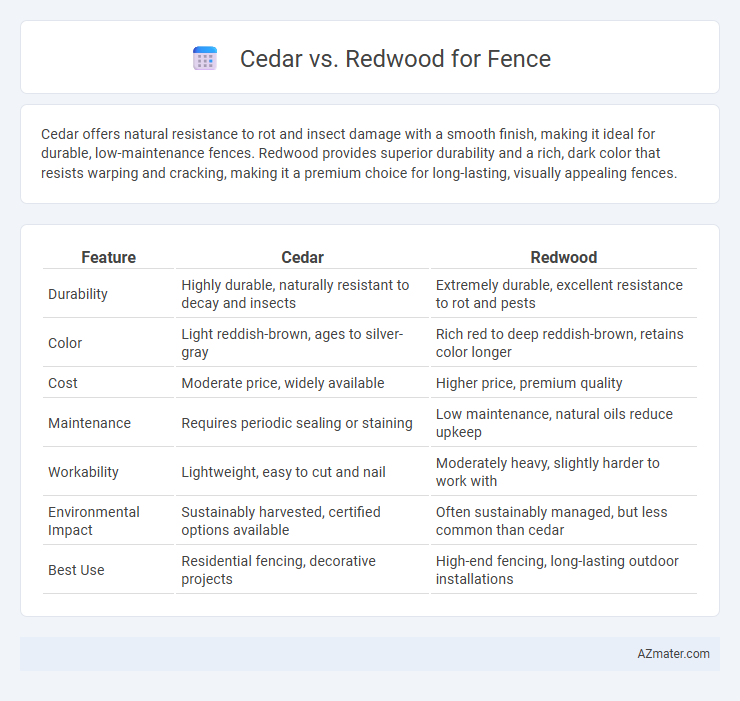Cedar offers natural resistance to rot and insect damage with a smooth finish, making it ideal for durable, low-maintenance fences. Redwood provides superior durability and a rich, dark color that resists warping and cracking, making it a premium choice for long-lasting, visually appealing fences.
Table of Comparison
| Feature | Cedar | Redwood |
|---|---|---|
| Durability | Highly durable, naturally resistant to decay and insects | Extremely durable, excellent resistance to rot and pests |
| Color | Light reddish-brown, ages to silver-gray | Rich red to deep reddish-brown, retains color longer |
| Cost | Moderate price, widely available | Higher price, premium quality |
| Maintenance | Requires periodic sealing or staining | Low maintenance, natural oils reduce upkeep |
| Workability | Lightweight, easy to cut and nail | Moderately heavy, slightly harder to work with |
| Environmental Impact | Sustainably harvested, certified options available | Often sustainably managed, but less common than cedar |
| Best Use | Residential fencing, decorative projects | High-end fencing, long-lasting outdoor installations |
Cedar vs Redwood: An Overview
Cedar and redwood are two of the most popular wood choices for fencing, prized for their natural resistance to decay and insects. Cedar tends to have a lighter color and a distinct aromatic scent, offering excellent stability and ease of working with hand tools. Redwood, on the other hand, boasts a rich reddish hue and typically features a higher density, providing enhanced durability and a longer lifespan in outdoor conditions.
Durability Comparison: Cedar and Redwood
Cedar and Redwood both offer strong durability for fencing, with Cedar naturally resistant to rot, decay, and insect damage due to its high natural oils and tannins. Redwood's heartwood provides excellent decay resistance and stability, especially in outdoor environments with moisture exposure, making it less prone to warping and splitting. Both woods can last 15 to 30 years or more with proper maintenance, but Cedar tends to perform better in humid climates, while Redwood excels in dry and sunny conditions.
Appearance and Color Differences
Cedar fences exhibit a warm, reddish-brown hue that ages to a soft silver-gray, providing a natural, rustic aesthetic ideal for traditional and cottage-style homes. Redwood fences display a deeper, rich reddish tone with prominent grain patterns, offering a striking visual impact and a luxurious appearance that stands out in modern and upscale settings. Both woods develop a beautiful patina over time, but redwood's color remains more vibrant longer due to its natural oils and tannins.
Resistance to Rot, Decay, and Insects
Cedar wood offers superior natural resistance to rot, decay, and insect damage due to its high levels of thujaplicins and natural oils, making it a durable option for fence construction. Redwood also provides excellent resistance, particularly heartwood from older trees, but is generally softer and more susceptible to mechanical damage than cedar. Both woods require periodic maintenance to sustain longevity, but cedar's inherent properties typically result in longer-lasting fences in humid and insect-prone environments.
Maintenance Requirements
Cedar fences require regular cleaning and annual sealing or staining to maintain their natural resistance to rot and insect damage, preserving their aesthetic appeal over time. Redwood fences benefit from high natural tannin content, offering strong resistance to decay and pests, and only need occasional cleaning and minimal sealing to prevent weathering. Both woods demand periodic inspections to address any localized issues, but redwood generally offers lower maintenance due to its durability and slower aging process.
Environmental Sustainability
Cedar and Redwood are both sustainable options for fencing due to their natural resistance to decay, reducing the need for chemical treatments. Cedar is typically sourced from faster-growing trees, offering a more renewable choice, while Redwood comes from older growth forests that require longer regeneration periods. Choosing FSC-certified Cedar or Redwood further ensures environmentally responsible forestry practices and minimizes ecological impact.
Cost Analysis: Cedar vs Redwood
Cedar fences typically cost between $15 and $30 per linear foot, making them a budget-friendly choice for durable and rot-resistant fencing. Redwood fences range from $25 to $40 per linear foot, reflecting the wood's premium quality and natural insect resistance. While cedar offers a more affordable upfront investment, redwood's longevity and low maintenance can reduce long-term expenses.
Ease of Installation and Workability
Cedar offers superior workability due to its lighter weight and softer texture, making it easier to cut, shape, and install compared to Redwood. Redwood is denser and heavier, which can slow down installation and require more effort or stronger tools for precise work. Both woods naturally resist decay and insects, but Cedar's consistent grain and reduced splintering contribute to a smoother, faster fencing project.
Longevity and Weather Performance
Cedar fences typically last between 15 to 20 years due to natural oils that resist rot and insect damage, making them highly durable in various weather conditions. Redwood fences can endure up to 25 years, benefiting from a dense composition that offers superior resistance to moisture, decay, and temperature fluctuations. Both woods provide excellent weather performance, but redwood's higher tannin content contributes to enhanced longevity and dimensional stability in harsh climates.
Best Choice for Your Fence: Cedar or Redwood?
Cedar and redwood are both popular choices for fencing due to their natural resistance to decay and insects, but cedar offers a lighter weight and easier workability, making it ideal for DIY projects. Redwood, known for its rich color and exceptional durability, tends to be more expensive but provides a longer-lasting, premium finish. Selecting between cedar and redwood depends on budget, aesthetic preference, and the desired lifespan of your fence.

Infographic: Cedar vs Redwood for Fence
 azmater.com
azmater.com